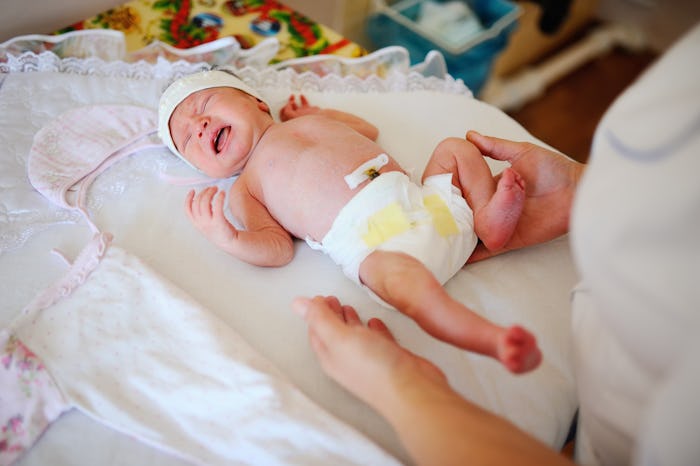Life

What's Up With Newborns' Belly Buttons?
Life after delivery has a bit of a learning curve to say the least. If you're a first time mom, learning to feed, clothe, change, wash, and generally care for a tiny human is a lot to handle. One question many first-time moms have in those first few days is how long it takes for baby's belly button to fall off after birth. It's an interesting question. Mainly because what moms refer to as the "belly button" is actually remnants from the umbilical cord. Once that gets cleared up, knowing when these remnants fall off and how to care for them until they do is one of those "rite of passage" skills every new mom has to learn.
The umbilical cord is your baby's literal lifeline during pregnancy, but once they enter the "real world" its no longer needed. So the doctors (or maybe your partner) will cut and clamp the cord, leaving a small stump behind. The stump is a bit like a wound, requiring special care and attention so that it doesn't get infected or irritated.
According to the American Pregnancy Association (APA), the cord stump usually takes up to two weeks to fall off. Until it does however, here are some tips for keeping it clean and healthy.
1Keep It Dry
For the stump to fall off on its own, it has to dry up first. The APA instructed parents to expose the stump to air as often as possible, be it through letting your baby wear only a diaper for a period of time, or with frequent diaper changes. Dress your baby in loose fitting clothes and buy the newborn diapers with special umbilical cord slots (or fold regular ones down below the stump) to ensure that your baby's diaper doesn't irritate it.
2Give Your Baby Sponge Baths Only Till It Falls Off
Sticking to sponge baths for the time being is the easiest and most practical option for bathing your baby until the stump falls off, according to the Mayo Clinic.
3Allow It To Heal On Its Own
Parents used to be instructed to clean the stump with rubbing alcohol with each diaper change, but now experts recommend letting the cord fall off on its own without any interference, according to the APA. Avoid touching or bumping the cord which can irritate and introduce infection.
4Watch Out For Signs Of Infection
Baby Center noted that its rare for the stump to become infected, but just in case, look out for redness around the area, signs that your baby is in pain when it's touched, or a yellow discharge and foul odor coming from the stump.